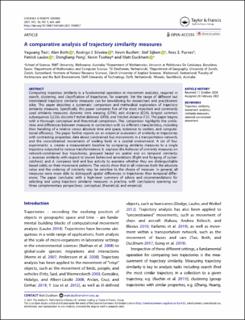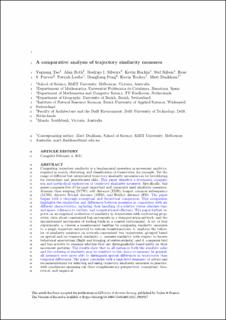Please use this identifier to cite or link to this item:
https://doi.org/10.21256/zhaw-24596Full metadata record
| DC Field | Value | Language |
|---|---|---|
| dc.contributor.author | Tao, Yaguang | - |
| dc.contributor.author | Both, Alan | - |
| dc.contributor.author | Silveira, Rodrigo I. | - |
| dc.contributor.author | Buchin, Kevin | - |
| dc.contributor.author | Sijben, Stef | - |
| dc.contributor.author | Purves, Ross S. | - |
| dc.contributor.author | Laube, Patrick | - |
| dc.contributor.author | Peng, Dongliang | - |
| dc.contributor.author | Toohey, Kevin | - |
| dc.contributor.author | Duckham, Matt | - |
| dc.date.accessioned | 2022-03-17T07:59:27Z | - |
| dc.date.available | 2022-03-17T07:59:27Z | - |
| dc.date.issued | 2021 | - |
| dc.identifier.issn | 1548-1603 | de_CH |
| dc.identifier.issn | 1943-7226 | de_CH |
| dc.identifier.uri | https://digitalcollection.zhaw.ch/handle/11475/24596 | - |
| dc.description.abstract | Computing trajectory similarity is a fundamental operation in movement analytics, required in search, clustering, and classification of trajectories, for example. Yet the range of different but interrelated trajectory similarity measures can be bewildering for researchers and practitioners alike. This paper describes a systematic comparison and methodical exploration of trajectory similarity measures. Specifically, this paper compares five of the most important and commonly used similarity measures: dynamic time warping (DTW), edit distance (EDR), longest common subsequence (LCSS), discrete Fréchet distance (DFD), and Fréchet distance (FD). The paper begins with a thorough conceptual and theoretical comparison. This comparison highlights the similarities and differences between measures in connection with six different characteristics, including their handling of a relative versus absolute time and space, tolerance to outliers, and computational efficiency. The paper further reports on an empirical evaluation of similarity in trajectories with contrasting properties: data about constrained bus movements in a transportation network, and the unconstrained movements of wading birds in a coastal environment. A set of four experiments: a. creates a measurement baseline by comparing similarity measures to a single trajectory subjected to various transformations; b. explores the behavior of similarity measures on network-constrained bus trajectories, grouped based on spatial and on temporal similarity; c. assesses similarity with respect to known behavioral annotations (flight and foraging of oystercatchers); and d. compares bird and bus activity to examine whether they are distinguishable based solely on their movement patterns. The results show that in all instances both the absolute value and the ordering of similarity may be sensitive to the choice of measure. In general, all measures were more able to distinguish spatial differences in trajectories than temporal differences. The paper concludes with a high-level summary of advice and recommendations for selecting and using trajectory similarity measures in practice, with conclusions spanning our three complementary perspectives: conceptual, theoretical, and empirical. | de_CH |
| dc.language.iso | en | de_CH |
| dc.publisher | Taylor & Francis | de_CH |
| dc.relation.ispartof | GIScience & Remote Sensing | de_CH |
| dc.rights | https://creativecommons.org/licenses/by/4.0/ | de_CH |
| dc.subject | Trajectory similarity | de_CH |
| dc.subject | Movement analytics | de_CH |
| dc.subject | Similarity measure | de_CH |
| dc.subject | Network-constrained movement | de_CH |
| dc.subject.ddc | 500: Naturwissenschaften | de_CH |
| dc.subject.ddc | 510: Mathematik | de_CH |
| dc.title | A comparative analysis of trajectory similarity measures | de_CH |
| dc.type | Beitrag in wissenschaftlicher Zeitschrift | de_CH |
| dcterms.type | Text | de_CH |
| zhaw.departement | Life Sciences und Facility Management | de_CH |
| zhaw.organisationalunit | Institut für Umwelt und Natürliche Ressourcen (IUNR) | de_CH |
| dc.identifier.doi | 10.1080/15481603.2021.1908927 | de_CH |
| dc.identifier.doi | 10.21256/zhaw-24596 | - |
| zhaw.funding.eu | No | de_CH |
| zhaw.issue | 5 | de_CH |
| zhaw.originated.zhaw | Yes | de_CH |
| zhaw.pages.end | 669 | de_CH |
| zhaw.pages.start | 643 | de_CH |
| zhaw.publication.status | publishedVersion | de_CH |
| zhaw.volume | 58 | de_CH |
| zhaw.publication.review | Peer review (Publikation) | de_CH |
| zhaw.webfeed | Datalab | de_CH |
| zhaw.author.additional | No | de_CH |
| zhaw.display.portrait | Yes | de_CH |
| Appears in collections: | Publikationen Life Sciences und Facility Management | |
Files in This Item:
| File | Description | Size | Format | |
|---|---|---|---|---|
| 2021_Tao-etal-Comparative-analysis-of-trajectory-similarity-measures.pdf | Published Version | 825.02 kB | Adobe PDF |  View/Open |
| 2021_Tao-etal_Trajectory-similarity-measures.pdf | Submitted Version | 810.81 kB | Adobe PDF |  View/Open |
Show simple item record
Tao, Y., Both, A., Silveira, R. I., Buchin, K., Sijben, S., Purves, R. S., Laube, P., Peng, D., Toohey, K., & Duckham, M. (2021). A comparative analysis of trajectory similarity measures. GIScience & Remote Sensing, 58(5), 643–669. https://doi.org/10.1080/15481603.2021.1908927
Tao, Y. et al. (2021) ‘A comparative analysis of trajectory similarity measures’, GIScience & Remote Sensing, 58(5), pp. 643–669. Available at: https://doi.org/10.1080/15481603.2021.1908927.
Y. Tao et al., “A comparative analysis of trajectory similarity measures,” GIScience & Remote Sensing, vol. 58, no. 5, pp. 643–669, 2021, doi: 10.1080/15481603.2021.1908927.
TAO, Yaguang, Alan BOTH, Rodrigo I. SILVEIRA, Kevin BUCHIN, Stef SIJBEN, Ross S. PURVES, Patrick LAUBE, Dongliang PENG, Kevin TOOHEY und Matt DUCKHAM, 2021. A comparative analysis of trajectory similarity measures. GIScience & Remote Sensing. 2021. Bd. 58, Nr. 5, S. 643–669. DOI 10.1080/15481603.2021.1908927
Tao, Yaguang, Alan Both, Rodrigo I. Silveira, Kevin Buchin, Stef Sijben, Ross S. Purves, Patrick Laube, Dongliang Peng, Kevin Toohey, and Matt Duckham. 2021. “A Comparative Analysis of Trajectory Similarity Measures.” GIScience & Remote Sensing 58 (5): 643–69. https://doi.org/10.1080/15481603.2021.1908927.
Tao, Yaguang, et al. “A Comparative Analysis of Trajectory Similarity Measures.” GIScience & Remote Sensing, vol. 58, no. 5, 2021, pp. 643–69, https://doi.org/10.1080/15481603.2021.1908927.
Items in DSpace are protected by copyright, with all rights reserved, unless otherwise indicated.